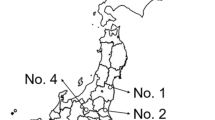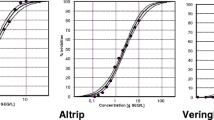Abstract
The ecotoxicity of nickel depends on water quality characteristics such as pH and dissolved organic carbon. Bioavailability models to predict nickel toxicity have been developed for and validated in European natural waters. In this study, we examined the acute toxicity of nickel to the strain of Daphnia magna that is used for toxicity tests in Japan, using water samples from five Japanese rivers. Based on the results of these toxicity tests, we examined the predictive capacity of the bioavailability model for acute nickel toxicity to D. magna and validated the model. The 50% effect and lethal concentrations (EC50 and LC50) of dissolved nickel for D. magna ranged from 0.52 to 4.0 mg/L and from 0.62 to 5.3 mg/L, respectively. Our results indicate that acute nickel toxicity varied as a result of the different water quality conditions in Japanese rivers. The bioavailability model predicted EC50 and LC50 values in water samples from Japanese rivers by errors more than a factor of 2, while the bioavailability models validated with the results of our toxicity tests were able to accurately predict these values with errors less than a factor of 2. Therefore, our results indicate that the bioavailability model validated using the results of the toxicity tests conducted using Japanese water samples could accurately predict acute nickel toxicity to the strain of D. magna.



Similar content being viewed by others
Data Availability
The online version of this article contains supplementary material, which is available to authorized users.
Change history
28 May 2021
A Correction to this paper has been published: https://doi.org/10.1007/s11270-021-05180-6
References
Adams, W., Blust, R., Dwyer, R., Mount, D., Nordheim, E., Rodriguez, P. H., et al. (2020). Bioavailability assessment of metals in freshwater environments: a historical review. Environmental Toxicology and Chemistry, 39(1), 48–59.
Bates, D. M., Watts, D. G. (1988). Nonlinear regression analysis and its application. New York: Wiley.
Cheng, T., De Schamphelaere, K. A. C., Lofts, S., Janssen, C. R., & Allen, H. E. (2005). Measurement and computation of zinc binding to natural dissolved organic matter in European surface waters. Analytica Chimica Acta, 542(2), 230–239.
Core Team, R. (2019). R: a language and environment for statistical computing. Vienna, Austria: R Foundation for Statistical Computing https://www.R-project.org/. .
De Schamphelaere, K. A. C., Heijerick, D. G., & Janssen, C. R. (2004). Comparison of the effect of difference pH buffering techniques on the toxicity of copper and zinc to Daphnia magna and Pseudokirchneriella subcapitata. Ecotoxicology, 13(7), 697–705.
De Schamphelaere, K. A. C., Van Laer, L., Deleebeeck, N. M. E., Muyssen, B. T. A., Degryse, F., Smolders, E. et al. (2006). Nickel speciation and ecotoxicity in European natural surface waters: development, refinement and validation of bioavailability models. Report prepared for the Nickel Producers Environmental Research Association. Gent University, Laboratory of Environmental Toxicology and Aquatic Ecology, Gent, Belgium. https://biblio.ugent.be/publication/5785290. .
Deleebeeck, N. M. E., De Schamphelaere, K. A. C., & Janssen, C. R. (2007). A bioavailability model predicting the toxicity of nickel to rainbow trout (Oncorhynchus mykiss) and fathead minnow (Pimephales promelas) in synthetic and natural waters. Ecotoxicology and Environmental Safety, 67(1), 1–13.
Deleebeeck, N. M. E., De Schamphelaere, K. A. C., Heijerick, D. G., Bossuyt, B. T. A., & Janssen, C. R. (2008a). The acute toxicity of nickel to Daphnia magna: predictive capacity of bioavailability models in artificial and natural waters. Ecotoxicology and Environmental Safety, 70(1), 67–78.
Deleebeeck, N. M. E., De Schamphelaere, K. A. C., & Janssen, C. R. (2008b). A novel method for predicting chronic nickel bioavailability and toxicity to Daphnia magna in artificial and natural waters. Environmental Toxicology and Chemistry, 27(10), 2097–2107.
Deleebeeck, N. M. E., De Schamphelaere, K. A. C., & Janssen, C. R. (2009). Effects of Mg2+ and H+ on the toxicity of Ni2+ to the unicellular green alga Pseudokirchneriella subcapitata: model development and validation with surface waters. Science of the Total Environment, 407(6), 1901–1914.
Environment Canada (2007). Biological test method: test of reproduction and survival using the cladoceran Ceriodaphnia dubia. EPS 1/RM/21, second edition. Method Development and Application Section, Environmental Technology Centre, Ottawa.
Garman, E. R., Meyer, J. S., Bergeron, C. M., Blewett, T. A., Clements, W. H., Elias, M. C., et al. (2020). Validation of bioavailability-based toxicity models for metals. Environmental Toxicology and Chemistry, 39(1), 101–117.
Han, S., Naito, W., Masunaga, S. (2016). Impact of bioavailability incorporation on ecological risk assessment of nickel, copper, and zinc in surface waters. Water, Air, and Soil Pollution, 227(12), 480.
Hayashi, T. I. (2013). Applying biotic ligand models and Bayesian techniques: ecological risk assessment of copper and nickel in Tokyo rivers. Integrated Environmental Assessment and Management, 9(1), 63–69.
Ministry of the Environment of Japan (MOE) (2018). Report of investigation on the water environmental quality standard for conservation of aquatic organisms in FY 2017. Tokyo, Japan (In Japanese with English abstract).
Nagai, T., Tsunemi, K., & Kawamoto, A. (2007). Metal speciation in natural river waters: measurement by diffusive gradients in thin-films and estimation by chemical equilibrium model. Japanese Journal of Limnology, 68(3), 391–401 (In Japanese with English abstract).
Naito, W., Mori, M., Iwasaki, Y., Kamo, M., & Masunaga, S. (2011). Measurement of bioavailability of metals in river water using DGT. Journal of Japan Society on Water Environment, 34(4), 65–71 (In Japanese with English abstract).
Natural Environment Research Council (NERC) (2001). Windermere humic aqueous model (WHAM), version 6. Swindon, UK: Natural Environment Research Council.
Nys, C., Janssen, C. R., Van Sprang, P., & De Schamphelaere, K. A. C. (2016). The effect of pH on chronic aquatic nickel toxicity is dependent on the pH itself: extending the chronic nickel bioavailability models. Environmental Toxicology and Chemistry, 35(5), 1097–1106.
Oda, S., Tatarazako, N., Dorgerloh, M., Johnson, R. D., Ole Kusk, K., Leverett, D., et al. (2007). Strain difference in sensitivity to 3,4-dichloroaniline and insect growth regulator, fenoxycarb, in Daphnia magna. Ecotoxicology and Environmental Safety, 67(3), 399–405.
Organization for Economic Co-operation and Development (OECD) (2004) Daphnia sp., acute immobilisation test. OECD guideline 202. Paris, France. https://doi.org/10.1787/9789264069947-en. Accessed 2 March 2020.
Organization for Economic Co-operation and Development (OECD) (2008). Validation report for an enhancement of OECD TG 211: Daphnia magna reproduction test. OECD Series on Testing and Assessment, Number 93. Organization for Economic Co-operation and Development, Paris, France. http://www.oecd.org/officialdocuments/publicdisplaydocumentpdf/?cote=env/jm/mono(2008)20&doclanguage=en. Accessed 2 March 2020.
Okamoto, A., Yamamuro, M., & Tatarazako, N. (2014). Acute toxicity of 50 metals to Daphnia magna. Journal of Applied Toxicology, 35(7), 824–830.
Ritz, C., Baty, F., Streibig, J. C., & Gerhard, D. (2015). Dose-response analysis using R. PLoS One, 10(12), e0146021.
Schlekat, C. E., Genderen, E. V., De Schamphelaere, K. A. C., Antunes, P. M. C., Rogevich, E. C., & Stubblefield, W. A. (2010). Cross-species extrapolation of chronic nickel biotic ligand models. Science of the Total Environment, 408(24), 6148–6157.
US Environmental Protection Agency (USEPA) (2002). Short-term methods for estimating the chronic toxicity of effluents and receiving waters to fresh organisms, fourth edition. EPA-821-R-02-013. Office of Water, Washington, DC.
Van Laer, L., Smolders, E., Degryse, F., De Schamphelaere, K. A. C., & Janssen, C. R. (2006). Speciation of nickel in surface waters measured with the Donnan membrane technique. Analytica Chimica Acta, 578(2), 195–202.
Acknowledgments
We thank W Naito, M Kamo, and Y Iwasaki for their assistance to sample river waters. We are grateful to A. Ueta, T. Nakata, and K. Uchino for their contribution to the experiment.
Funding
This research was funded by the Steel Foundation for Environmental Protection Technology.
Author information
Authors and Affiliations
Corresponding author
Ethics declarations
Conflict of Interest
The authors declare that they have no conflict of interest.
Ethical Approval
All applicable international, national, and/or institutional guidelines for the care and use of animals were followed.
Consent to Participate
Not applicable.
Consent for Publication
Not applicable.
Disclaimer
This paper does not necessarily reflect the policies or views of any government agencies.
Code Availability
Not applicable.
Additional information
Publisher’s Note
Springer Nature remains neutral with regard to jurisdictional claims in published maps and institutional affiliations.
Electronic Supplementary Material
ESM 1
(DOCX 794 kb)
Rights and permissions
About this article
Cite this article
Mano, H., Shinohara, N. Acute Toxicity of Nickel to Daphnia magna: Validation of Bioavailability Models in Japanese Rivers. Water Air Soil Pollut 231, 459 (2020). https://doi.org/10.1007/s11270-020-04842-1
Received:
Accepted:
Published:
DOI: https://doi.org/10.1007/s11270-020-04842-1




